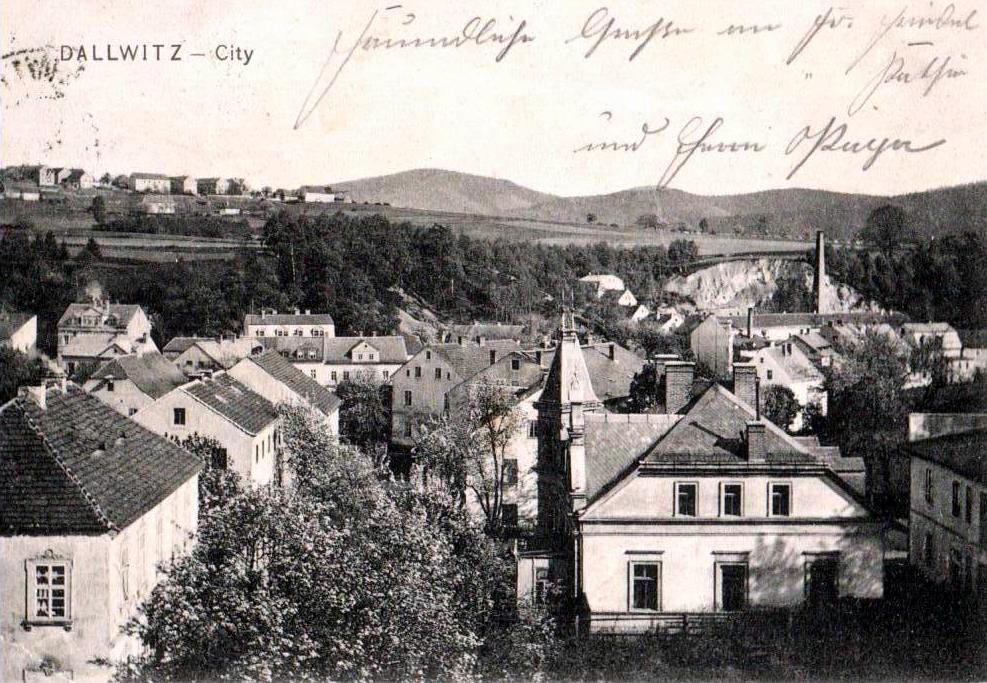History of village
Chronicles of village
.jpg)

New castle Old castle
For the first time Dalovice (in the past mentioned under the names Dallowicz, Dallwicz, Dallwitz, Dalvice) was mentioned in municipal books from 1498. Since then Dalovice received its name. But it does not mean that people did not live there before.
During the 20th century archeological excavation showed, that close to the site called „Tvrziště“ people lived already in the late Bronze Age (approx. 1200 – 700 years B.C.) Discoveries from the excavations are displayed in the Museum of Karlovy Vary. Among other you find there foundations of residential tower from the end of the 12th century that belonged to the ancient wooden fortress. New atrium type fortress was built nearby after the fire of the original fortress at the beginning of 15th century. The new fortress was known under the name „Telbicz“. This fortress was largely damaged by the army of count Šlik in 1502. Despite it had been partly repaired, it was not possible to live in there anymore. During the 16th century new residential building, called „Old Manor“, was built nearby.
As the income from the area was rather low (agricultural and forest area), owners of Dalovice used to change frequently. In order to increase the income, one of the owners – Johann Wenzel Ferdinand, Ritter von Schönau – founded in 1804 clay manufactory (later in 1830 it became porcelain factory called Epiag).
The most important person of the village history was Baronet Friedrich Riedl von Riedenstein, who bought the whole area including the porcelain factory in 1871.
Between 1874 and 1875 he had also built so called „Nový zámek“ (New Manor) (nowadays the seat of The School of Logistics). In 1889 he sold the porcelain factory to Baronet Springer, owner of the porcelain factory in Loket. „Starý zámek“ (Old Manor), which served as dormitory for the factory employees, was damaged by fire in 1898. In following years Friedrich Riedl von Riedenstein had built new manor building that took over the name „Starý zámek” (nowadays the seat of The Secondary School of Agriculture).
Baronet Friedrich Riedl von Riedenstein died in 1905. The area inherited his oldest son Eduard, who markedly enlarged manor library by extensive collections of German, English and French literature (mainly geographical and travel books). The Riedl von Riedenstein family owned the Dalovice area until 1945 when the Czechoslovakia state took over.
Manor Park with dominant Körner´s oak tree is one of the most interesting places in Dalovice. Already in 1811, poet Theodor Körner, who had been taking spa treatments in Karlovy Vary, used to go for walks to Dalovice and sang about the oaks in its park. There were five big oaks by that time. At the end of the19th century there remained three oaks while today remains just one, so called Körner oak. It is a memorable tree and belongs to the oldest in the Czech Republic (estimated age700 - 900 years). The girth of the tree is 8, 87 m and its height is 18 m. Nearby stands the bronze bust of Theodor Körner from 1913 made by sculptor L. Tischler.
When coming to Dalovice along Vitice stream you cannot miss “Kostel Panny Marie Utěšitelky ” (the church of Virgin Mary the Comforter). The church was built in 1929 (original chapel from 1898 became part of the new church).
Dalovice was an independent village until 1976 when it was connected to Karlovy Vary and became its urban part. In 1990 Dalovice managed to separate again under the condition that the villages Všeborovice and Vysoká became indivisible part of the village.
Všeborovice, today part of Dalovice, used to be an independent village (previous names Schobrowitz, Šobrovice). First remarks on Všeborovice are noted in the yield of tax from 1523 and that year is therefore considered to be the foundation year of the village.
The oldest part of Všeborovice was founded as a site between the 10th and the 12th century and was situated at the place today called „Horní Všeborovice“ (Upper Všeborovice). The later part, “Dolní Všeborovice” (Lower Všeborovice), was not founded until 1880. It was suggested by Baronet Fiedrich Riedl von Riedenstein in order to provide the industrial part of Dalovice (porcelain factory, coal mines) with agricultural supplies.
Všeborovice was independent village until 1960, then it was connected to Dalovice.
Vysoká, nowadays another part of Dalovice, was founded in the 15th century as a settlement belonging to Dalovice (it used to be called Hohdorf, Hochdorf, Hohendorf). Vysoká as an independent village was first mentioned in 1655 while documenting the assets of nobility. In the contrary to Dalovice and Všeborovice, which were founded by Slavs, Vysoká was originally inhabited by Germans. After 1945 there was only a small group of Sudeten citizens left, today most of the inhabitants are Czech.
A place of interest in Vysoká is chapel from 1895, which was built close to the original one from 1782.
Vysoká stayed independent until 1952 when it was connected to Dalovice.

Postcards of village





